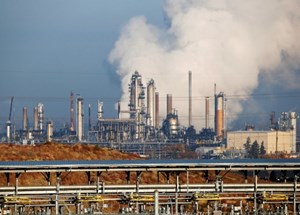Details of Canada's planned regulations to limit oil and gas emissions

(Reuters) - Canada unveiled planned regulations on Thursday to limit emissions from the oil and gas sector using a cap-and-trade system, fulfilling a promise by Prime Minister Justin Trudeau's government to cut emissions in its most polluting sector.
Here are details on the proposed regulations:
*Cap-and-trade is a market-based system where the regulator limits emissions and issues emissions allowances that producers can use if they exceed the cap.
*The government proposes to cap 2030 emissions at 35% to 38% below 2019 levels, or at 106 to 112 megatons compared with 171 megatons in 2019, while providing compliance flexibilities - or allowances - to emit up to a level about 20% of 23% below 2019 levels, or up to 131 to 137 megatons.
*In 2021, the oil and gas sector was the largest source of greenhouse gas (GHG) emissions, accounting for 28% of total national emissions with 189 megatons of carbon dioxide equivalent (Mt CO2 eq) emitted, according to official data. In 2021, the sector's GHG emissions were 3% higher than in 2020. Over the period from 1990 to 2021, the sector's GHG emissions increased by 88%.
*Each emission allowance would be equivalent to one ton of carbon dioxide equivalent (CO2e). Emission allowances issued under the cap-and-trade regulations would not be fungible with other carbon pricing systems or regulatory instruments. Allowances will initially be free.
*Emission allowances would be tradeable among covered facilities but would be unique to the oil and gas emissions cap-and-trade system. Likewise, surplus credits, performance credits or other permits or allowances from other regulations or carbon pricing systems, including federal and provincial output-based pricing systems or cap-and-trade systems, would not be eligible within the oil and gas emissions cap-and-trade system.
*Covered facilities would have the option to remit offset credits from Canada's GHG Offset Credit System and provincial offset credits recognized for use under the federal Output-Based Pricing System Regulations for up to the percentage of GHG emissions between the cap (total allowances issued in a given year) and the legal upper bound. This is a maximum of approximately 20% of a facility’s GHG emissions.
*The cap-and-trade system would cover all direct GHG emissions, while also accounting for indirect emissions related oil and gas production and carbon storage. The GHGs covered would include carbon dioxide, methane and nitrous oxide.
*The GHG pollution cap would regulate upstream oil and gas facilities, including offshore facilities, and would also apply to liquefied natural gas facilities. These subsectors represent the majority of oil and gas sector emissions — the upstream subsector represented 85% of sector emissions in 2021. The emissions cap will cover activities such as oil sands, conventional oil production, natural gas production and processing, and liquefied natural gas production.
*After further consultations, the government will issue draft regulations toward the middle of 2024. The regulations are targeted to come into force upon registration of the final regulations in 2025. Facilities would be required to register before the end of 2025, or before releasing GHGs as a result of carrying out a covered activity after January 1, 2026.
Related News
Related News

- ExxonMobil halts 1-Bft3d blue hydrogen project in Texas
- Aramco and Yokogawa commission multiple autonomous control AI agents at Fadhili gas plant
- Ukraine will resume gas imports via Transbalkan route in November
- Mitsubishi to inject $260 MM into Brunei LNG project
- Freeport LNG (U.S.) on track to take in more natgas on Thursday after unit outage



Comments